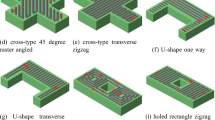Abstract
This paper proposes a new part family classification system (IPFACS: Image Processing and Fuzzy ART based Clustering System), which incorporates image processing techniques and a modified Fuzzy ART neural network algorithm. IPFACS can classify parts based on geometrical shape and manufacturing attributes, simultaneously. With a proper reduction and normalization of an image data through the image processing methods and scaling capability in the modified Fuzzy ART, different types of geometrical shape data and manufacturing attribute data can be simultaneously classified in the same system. IPFACS has been tested for an example set of hypothetical parts. The results show that IPFACS provides a good feasible approach to form part families based on both geometrical shape and manufacturing attributes.
Similar content being viewed by others
References
Ahmed, N. and Bates, R. M. (1971) A power spectrum and related physical interpretation for the multi dimensional BIFORE transform, in Proceedings: Applications of Walsh Functions Symposium, Naval Res. Lab., AD-727-000, pp. 47–50.
Bhadra, A. and Fischer, G. W. (1988) A new GT classification approach: a data base with graphical dimensions. Manufacturing Review, 1(1), 44–49.
Burke, L. I. (1991) Original contribution: clustering characterization of adaptive resonance. Neural Networks, 4, 485–491.
Burke, L. and Kamal, S. (1992) Fuzzy ART for cellular manufacturing, in Proceedings of the Conference on Artifcial Neural Networks in Engineering, 1, pp. 779–784.
Carpenter, G. A., Grossberg, S. and Rosen, D. B. (1991) Fuzzy ART: fast stable learning and categorization of analog patterns by an adaptive resonance system (original contribution). Neural Networks, 4, 759–771.
Chung, Y. and Kusiak, A. (1994) Grouping parts with a neural network. Journal of Manufacturing Systems, 13(4), 262–275.
Fausett, L. (1994) Fundamentals of Neural Networks–Architectures, Algorithms, and Applications, Prentice Hall International Inc., New Jersey.
Gonzalez, R. C. and Woods, R. E. (1992) Digital Image Processing, Addison-Wesley Publishing Co., Tokyo.
Han, S. H., Lee, S. Y. and Jeon, D. H. (1997) Robust planar shape recognition using spectrum analyzer and fuzzy ARTMAP. Journal of Fuzzy Logic and Intelligent Systems, to appear.
Kamal, S. and Burke, L. I. (1996) FACT: A new neural network-based clustering algorithm for group technology. International Journal of Production Research, 34(4), 919–946.
Kaparthi, S. and Suresh, N. C. (1991) A neural network system for shape-based classification and coding of rotational parts. International Journal of Production Research, 29(9), 1771–1784.
Kaparthi, S. and Suresh, N. C. (1992) Machine-component cell formation in group technology: a neural network approach. International Journal Production Research, 30(6), 1353–1367.
Ko, C. N. and Rhee, J. T. (1994) Grouping parts by part shape and sequence of operations using neural network, in Proceedings of Korea IIE.
Kusiak, A. and Chung, Y. (1991) GT/ART: Using neural networks to form machine cells. Manufacturing Review, 4(4), 293–301.
Lee, S. K. and Jang, D. S. (1996) Translation, rotation and scale invariant pattern recognition using spectral analysis and hybrid genetic-neural-fuzzy networks. Computers and Industrial Engineering, 30(3), 511–522.
Liao, T. W. and Chen, L. J. (1993) An evaluation of ART1 neural models for GT part family and machine cell forming. Journal of Manufacturing Systems, 12(4), 282–290.
Liao, T. W. and Lee, K. S. (1994) Integration of a feature-based CAD system and an ART1 neural model for GT coding and prt family forming. Computers and Industrial Engineering, 26(1), 93–104.
Mathworks Inc. (1992) MATLAB–Reference Guide.
Moon, Y. B. (1990) Forming part-machine families for cellular manufacturing: a neural-network approach. International Journal of Advanced Manufacturing Technology, 5278–291.
Moon, Y. B. and Chi, S. C. (1992) Generalized part family formation using neural network techniques. Journal of Manufacturing Systems, 11(3), 149–159.
Nemcek, W. F. and Lin, W. C. (1974) Experimental investigation of automatic signature verification. IEEE Transactions on Systems, Man, and Cybernetics, 121–126.
Shafer, S. M. and Meredsith, R. (1990) A comparison of selected manufacturing cell formation techniques. International Journal of Production Research, 28(4), 661–673.
Sonka, M., Hlavac, V. and Boyle, R. (1993) Image Processing, Analysis and Machine Vision, Chapman & Hall, London.
Suresh, N. C. and Kaparthi, S. (1994) Performance of fuzzy ART neural network for group technology cell formation. International Journal of Production Research, 32(7), 1693–1713.
Author information
Authors and Affiliations
Rights and permissions
About this article
Cite this article
LEE, S.Y., FISCHER, G.W. Grouping parts based on geometrical shapes and manufacturing attributes using a neural network. Journal of Intelligent Manufacturing 10, 199–209 (1999). https://doi.org/10.1023/A:1008932922695
Issue Date:
DOI: https://doi.org/10.1023/A:1008932922695




